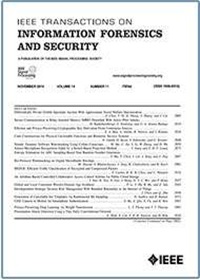Constant-Modulus Secure Analog Beamforming for an IRS-Assisted Communication System With Large-Scale Antenna Array
IF 6.3
1区 计算机科学
Q1 COMPUTER SCIENCE, THEORY & METHODS
IEEE Transactions on Information Forensics and Security
Pub Date : 2025-03-11
DOI:10.1109/TIFS.2025.3550053
引用次数: 0
Abstract
Physical layer security (PLS) is an important technology in wireless communication systems to safeguard communication privacy and security between transmitters and legitimate users. The integration of large-scale antenna arrays (LSAA) and intelligent reflecting surfaces (IRS) has emerged as a promising approach to enhance PLS. However, LSAA requires a dedicated radio frequency (RF) chain for each antenna element, and IRS comprises hundreds of reflecting micro-antennas, leading to increased hardware costs and power consumption. To address this, cost-effective solutions like constant modulus analog beamforming (CMAB) have gained attention. This paper investigates PLS in IRS-assisted communication systems with a focus on jointly designing the CMAB at the transmitter and phase shifts at the IRS to maximize the secrecy rate. The resulting secrecy rate maximization (SRM) problem is non-convex. To solve the problem efficiently, we propose two algorithms: 1) the time-efficient Dinkelbach-BSUM algorithm, which reformulates the fractional problem into a series of quadratic programs using the Dinkelbach method and solves them via block successive upper-bound minimization (BSUM), and 2) the product manifold conjugate gradient descent (PMCGD) algorithm, which provides a better solution at the cost of slightly higher computational time by transforming the problem into an unconstrained optimization on a Riemannian product manifold and solving it using the conjugate gradient descent (CGD) algorithm. Simulation results validate the effectiveness of the proposed algorithms and highlight their distinct advantages.求助全文
约1分钟内获得全文
求助全文
来源期刊

IEEE Transactions on Information Forensics and Security
工程技术-工程:电子与电气
CiteScore
14.40
自引率
7.40%
发文量
234
审稿时长
6.5 months
期刊介绍:
The IEEE Transactions on Information Forensics and Security covers the sciences, technologies, and applications relating to information forensics, information security, biometrics, surveillance and systems applications that incorporate these features
 求助内容:
求助内容: 应助结果提醒方式:
应助结果提醒方式:


